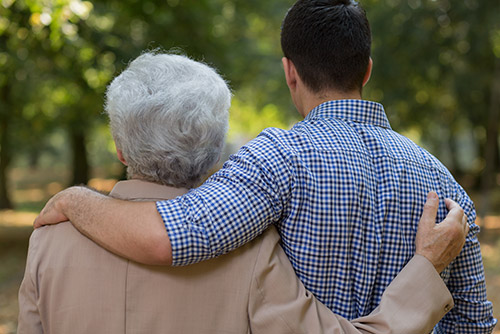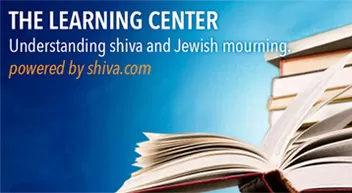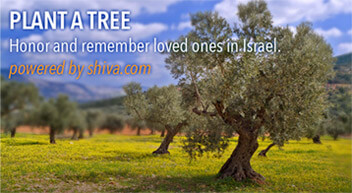Birth is a beginning, And death a destination. And life is a journey, A sacred pilgrimage – To life everlasting – Alvin Fine

We serve Jewish families within all three branches of Judaism, whether affiliated with a community or synagogue, or not. Often, families would like to follow Jewish funeral traditions but are not familiar with what it entails. We can help you learn about the traditions and incorporate the rituals and practices that are meaningful to you.
What are the preparations before burial?
There are two important principles in the Jewish faith regarding death and mourning. The first, k’vod ha-met, requires that the body be treated with the utmost of respect from the time of passing until burial is completed. The second is the idea that death is a natural process, a normal part of the life cycle.
In traditional Jewish funerals, the body is prepared for burial in a special way, involving a series of steps. The chevra kadisha (holy burial society) is made up of practicing Jews who help prepare the deceased’s body for burial. This includes properly washing the body, referred to as tahara. As members of this burial society wash the deceased’s body — men prepare deceased men’s bodies, while women prepare deceased women’s bodies — they also recite prayers for the dead. After this ritual washing, the deceased’s body is dressed in traditional burial clothing, called tachrichim. They are simple white garments, usually made from 100% pure linen and are meant to ensure equality between rich and poor; all are buried in the same garments. In addition, tradition says that since these shrouds have no pockets, wealth or status cannot be expressed or acknowledged in death.
The biblical basis for this practice is found in Ecclesiastes 5:14, which reads, “He shall depart, just as he came.” Since one is washed at birth, it is interpreted, one should also be washed at death. The simple white garment is meant to signify that we are all equal in death and we are judged on our merits and deeds, not material possessions.
Many men and women are buried in their tallit (prayer shawl). One of the fringes of the tallit is cut to show that it will no longer be used. Some people are buried in their typical daily dress.
In traditional Jewish practice, the deceased is not left alone from the time of death until burial. This ritual act of shemirah (“watching,” “guarding”) is performed as a sign of respect to the deceased. A shomer, a Hebrew word for meaning “guard,” sit with the deceased from the time of death until the time of the funeral. This custom is based on the desire not to leave a loved one unattended and may be handled, on a rotating basis, by members of the chevrah kadisha, who read psalms, prayers, or study sacred texts while in attendance.
When should the burial take place?
While Jewish tradition requires that burial take place as soon as practical following death, we understand that modern life doesn’t always allow for this—family members from outside the area may need to travel to attend the funeral, your rabbi or the person you want to lead the service may not be available, and participating cemeteries may have limitations that impact scheduling.
* Funerals are not held on Shabbat; on the Festival Days of Pesach, Shavuot, and Sukkot; or on the High Holy Days.
The Jewish Service
Jewish funerals are characterized by brevity and simplicity. They are designed for the honor and dignity of the deceased and are a part of the mourning process which helps comfort the bereaved. Generally, most of the service takes place in the funeral home or synagogue. Sometimes the entire service is conducted at the gravesite.
What does Kriah mean?
K’riah is the Hebrew word for “tear.” Just prior to the start of the funeral service, the immediate family comes together and a piece of clothing or a black ribbon is torn and worn as an expression of one’s grief. It is always performed standing, which shows strength at a time of grief. The torn garment or ribbon is worn during the seven days of shiva (but not on Shabbat and Festival Days).
If the person is mourning the death of a parent, the ribbon/cloth is worn on their left side, over the person’s heart. All other relatives in mourning, which includes siblings, spouse and parents, wear the ribbon/cloth on their right side.
What takes place during a funeral service?
Immediately following k’riah, the family is seated in the front row of the chapel or synagogue. The closed coffin remains in view. Traditionally, it is not decorated with flowers.
The service may begin with one or more psalms. The psalm most commonly recited is Psalm 23. Whoever is officiating the service, will then proceed with several readings from Psalms or other inspirational sources. Nowadays, the eulogy is often delivered by family members. However, many families prefer to have the rabbi or cantor, who has met with the family prior to the funeral to learn about the deceased and the particular attributes the family would like mentioned. The eulogy will typically contain personal reminiscences and sometimes humorous anecdotes as well. Frequently other members of the family or friends will also speak, sharing personal thoughts about their loved one.
The final prayer of the funeral service is the El Malei Rachamim (Hebrew for “God, full of compassion”). At the close of the service, an announcement is made informing those present about where the interment will be, where and when shiva will be observed and if there are designated charities or organizations to make memorial contributions.
What happens at the cemetery?
At the conclusion of the chapel service, family and friends who will attend the burial service form a procession behind the hearse to the gravesite. At the cemetery, the casket is removed from the hearse and carried to the grave. Some families choose to appoint “pallbearers” – usually at least six people (men or women) who assist in carrying the casket; this is considered to be a great honor.
The customs and practices surrounding the interment vary within each branch of Judaism. The casket is lowered into the grave by hand or by mechanical device. Here family and friends are invited to shovel earth into the grave. It is considered both a duty and an honor to help in filling the grave. As this is done, the shovel is usually not passed directly from one person to the next, but is placed on the ground before being picked up each time. This gesture symbolizes the hope that the tragedy of death will not pass from one person to another, and also symbolizes the desire not to rush this final parting from the deceased. This final act helps mourners with acceptance and closure.
Some families prefer not to be present for the lowering of the casket. They may wish to place several handfuls of earth on the casket which is lowered after the mourners leave.
According to tradition, once the burial is over, the emphasis shifts from honoring the deceased to comforting the mourners. After the appropriate prayers have been recited, friends and family traditionally form two lines, facing each other, so the immediate mourners may walk between them to hear the first words of comfort after the burial, “ha-makom y’nachem etchem b’toch sh’ar aveilei tzion vi-rushalayim.”
“May God comfort you now among the mourners for Zion and Jerusalem.”
What happens after the cemetery?
The family and friends return home to “sit Shiva”. Shiva is observed in the home of the deceased or at a close relative’s house. Upon returning home from the cemetery, mourners and friends traditionally wash their hands before they enter the house, and a pitcher of water and a basin are set outside the home for visitors to cleanse themselves–metaphorically–as they return from a place of death to a place of life.
A special candle (provided by the funeral home) is lit upon returning from the cemetery and it burns for the entire shiva period. In Proverbs 20:27 we read: “The human soul is the light of God.” The candlelight symbolizes the soul of the deceased as well as the presence of God. It is a sign of respect to the memory of the deceased.
Remembering a loved one
Even though our loved ones have died, it is still important to remember and honor them, not just for ourselves, but for our children and grandchildren. We do so through ritual, the recitation of Kaddish and tzedakah.
In the Jewish tradition, one of the greatest honors one can bestow on someone is to perform a mitzvah on their behalf. Those who want to express their condolences to the family in a tangible way may perform the mitzvah of tzedakah. The most common form of tzedakah is to make a donation to a charity that was most meaningful to the departed. Another favored tradition is to send food to family at the shiva location.
Is it appropriate to send flowers?
Traditionally a memorial contribution to a charitable cause will be listed as an alternative to sending flowers. This is a way to honor the deceased that is a preferred and lasting remembrance.
The meal of condolence
The first meal eaten by the mourners upon returning from the cemetery is called the meal of condolence. Often prepared and served by friends, this meal creates an atmosphere of support. It is Jewish custom to include round foods, especially hard-boiled eggs. Round foods remind us of the cycle of life – which inevitably includes death. Eggs, in particular symbolize new life which goes on, even in the face of death.
What is Shiva?
As mentioned earlier, immediately following the burial, the focus of attention shifts from the deceased to the mourners. Up to this time, our attention has been centered on saying farewell to our loved one. Now it is the time to help our friends and family adjust to their loss. Shiva refers to the seven-day period immediately following the burial. (The day of the burial is the first day). During shiva, a minyan––worship service––is traditionally held at the house of mourning. The service is held so that the bereaved are afforded the opportunity to recite the Mourner’s Kaddish.
An integral part of shiva is the condolence call. It is a mitzvah to visit a house of mourning during the shiva period. The custom of comforting the mourners is derived from Job 2:13, when Job is joined by his friends as he mourns the loss of his children: “So they sat down with him upon the ground for seven days and seven nights, and none spoke a word to him for they saw that his grief was very great.” The Talmud teaches that consoling mourners is an act of God. The purpose of the condolence call is to offer companionship to the mourners – to offer support and a sympathetic ear. When visiting a shiva house, let the mourners initiate the conversation. Let them choose what to talk about, or let them choose silence. Visitors may ask to hear stories about the person who died, or tell stories that would honor him or her. It is important to speak of the deceased. In this way, the bereaved recall the many events which bound their lives to their loved one. The period of shiva allows mourners to express their grief openly and without restraint. Those who are bereaved need to grieve with the understanding and support of friends and family.
More Jewish Traditions
Kaddish
The prayer we call Kaddish appears in every worship service. There are five variations of the basic Kaddish, one of which is the Mourner’s Kaddish. This prayer is one of the most beautiful in Judaism, and many find its words a comfort when they are sorrowful. The cadences are important for the bereaved even when the meaning of specific words may not be known. The Kaddish is an ancient prose-poem that developed over a period of centuries. Among its earlier purposes was to divide parts of the service. With the exception of the last verse, which is in Hebrew, the Kaddish is written in Aramaic and means “sanctification.” It is related to the Hebrew word kadosh (“holy”). Though most versions of the Kaddish contain no mention of death, the Kaddish came to be recited by mourners during the 13th century. It praises God, affirms God’s holiness, and anticipates the establishment of peace on earth. At the very moment when our faith may be most tested, we praise God, our Creator, and we pray for the unification and completion of a world we feel is fragmented.
The words of the Kaddish create a fellowship with others who have suffered loss. It is said in the presence of a public quorum of ten adults (minyan). When a parent dies, one recites Kaddish for eleven months. Many Jews say it for a full year, retaining the Talmudic custom of mourning. Kaddish is usually recited for a 30-day period for other close relatives – son, daughter, brother, sister, and spouse – although sometimes individuals choose to extend the Kaddish period beyond thirty days. Kaddish is also said each year on the anniversary of the death of a loved one (yahrzeit) and at Yizkor services.
Reciting the Kaddish in memory of our beloved dead brings us all closer, as our voices rhythmically echo all those who have mourned before us. In that moment, we form a community which transcends death.
Unveiling
“Unveiling” refers to the dedication of a memorial stone and is often used to mark the end of the mourning period. Jewish law requires that a monument be placed on the grave of every Jew to mark the gravesite clearly and permanently. The headstone or footstone may be erected at the end of shiva or up to twelve months after death.
Jewish law and tradition require no special ritual for the unveiling. However, it has become an American Jewish tradition to have a formal unveiling ceremony, at which time family and friends visit the grave and view the newly erected headstone. Although anyone can officiate at an unveiling, it can provide comfort to the family to have a rabbi or cantor lead the recitation of a few prayers, such as El Malei Rachamin and Kaddish, and say a few words.
Yahrzeit
Traditionally, the anniversary, yahrzeit, of the deceased’s death is observed annually. The word is derived from Yiddish and means “year’s time.” It is traditionally observed according to the Hebrew date of death, although some Jews follow the secular calendar.
Many Jews light a yahrzeit candle to commemorate the day. The candle is lit at sunset on the evening before the anniversary and is allowed to burn itself out. There are no standard prayers or prescribed blessings to accompany the lighting of the candle. We send reminders to our families via email. Please let us know, if you would like to participate and we will gladly send you reminders. Contact us at [email protected]
Kaddish is recited on the day of yahrzeit or on the Shabbat before the yahrzeit.
Many people visit the cemetery on or close to the yahrzeit, and perform the mitzvah of giving tzedakah or engage in other acts of special kindness at this time.
Visiting the grave
Judaism discourages frequent grave visitation for it may hinder the mourner’s return to normal life. However, there are days when it is traditional to visit the cemetery, such as the days before the High Holy Days and special personal days such as birthdays and anniversaries.
Putting stones on top of a grave
Although the origin of this ritual is not known, it may refer back to ancient times when a community collectively built a pile of stones to mark the burial site. Each rock is an enduring token, marking the mourner’s visit to the grave and their memory of their loved one.
Yiskor
A memorial service, Yizkor (Hebrew for “may God remember”) is held in synagogues on four occasions during the year – Yom Kippur, Shemini Atzeret, and the last days of Pesach and Shavuot. Yizkor usually takes place in the morning after a Torah service. Many Jews light a memorial candle on the eve of days on which Yizkor is said.
Passover: April 27, 2018
Shavuot: May 21, 2018
Yom Kippur: September 19, 2018
Shemini Atzeret: October 1, 2018









